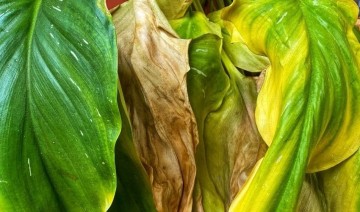
The Issue With Overwatering Houseplants
Houseplants need regular watering in order to take up nutrients from the potting soil, to nourish new growth, and to keep their foliage lush and full. But overwatering can cause a variety of problems, and can even be fatal for a houseplant.
The Watering Houseplants Need
Different houseplants can have dramatically different watering needs. Understanding the factors that can affect how much water plants need will help you be sure to provide each plant with adequate water without the risk of overwatering. When watering different plants, consider…
- Species – Many tropical plants with large, lush foliage and bright blooms can seem to be always thirsty, while different cacti and succulents need very little water to do their best.
- Size – Larger plants typically need more water than smaller plants, because extra water is necessary to reach all the stems and foliage to keep them firm and well-fed.
- Pot Size – Plants in larger pots have more room to spread out, but also need more water to reach all their roots. Smaller pots dry out more quickly than larger pots.
- Drainage – Well-draining soil won’t hold water and will dry out faster than organically rich, dense soil. If the soil can’t hold water for long, plants will need more frequent watering.
- Climate – The surrounding climate affects how much watering a houseplant needs. Temperature, humidity, and light levels all impact plant moisture needs.
- Season – Houseplants generally need more water in the spring and summer when they are actively growing, but need less water when they are dormant in fall and winter.
Taking these factors into consideration can help you properly water different houseplants, adjusting that watering as necessary when their needs change.
Signs of an Overwatered Houseplant
Overwatering is one of the most common ailments of houseplants, and there are many signs that can indicate if your plant has been watered too much. If your plant shows any of the following, it may be getting too much water…
- Root rot, including blackened or dying roots
- Excessive leaf yellowing or browning
- Limp or wilted leaves when the soil is still damp
- Mold on the lower parts of the plant or on the soil
- Very slow growth or no new growth at all
- Pests, especially gnats or spider mites that thrive in damp soil
- Soaked soil and constant drainage from the pot
While one symptom alone may not prove that a plant is suffering from overwatering, it is best to eliminate overwatering as a cause of any of these symptoms. If multiple symptoms are present, overwatering is the most likely culprit for a houseplant’s decline.
Saving an Overwatered Houseplant
Not all overwatered houseplants are automatically doomed. If the damage is not too severe and the problem is caught right away, it is possible to salvage the plant and help it thrive again.
First, carefully trim away any brown or yellowed leaves. This damage will not reverse, and trimming the foliage will immediately give the plant a perkier, healthier look. If there is standing water in the plant’s saucer, it should be discarded, and extra drainage holes can be added to the pot to promote more effective drainage so the roots do not get soaked.
Ideally, an overly soaked plant should be gently removed from its pot so it isn’t soaking in excess moisture for long. Inspect the roots for signs of rot, and trim away roots that have already died and blackened. Loosen the root ball slightly to allow air to circulate, and consider poking a few narrow holes through the topsoil and into the roots to allow for better drainage and air circulation. Keep the plant out of its pot and drying out for 4-6 hours, using the time to remove any visible mold or fungus that may have grown on the plant or soil.
Once the plant has begun to dry out and is no longer soaking, it can be reinserted into its pot or repotted into a new container with high quality potting soil that will drain adequately. If necessary, add a layer of lava rock or similar rocks to the bottom of the pot to promote better drainage.
Despite these efforts, it isn’t always possible to save an overwatered houseplant, especially if the overwatering has been a chronic problem or the plant is delicate to watering changes.
Avoid Overwatering Houseplants
The best way to correct overwatering is to avoid giving houseplants too much water in the first place. Before choosing a new plant, research its watering, soil type, and climate needs, and try to give it the very best care right from the beginning. Use a properly sized pot with good drainage, and a high quality potting soil suited to the plant’s nutritional needs.
Before watering a houseplant, check the soil’s moisture. If the top inch or two of soil is thoroughly dry, it is time for watering, but if the soil is still damp, it is best to wait. Most houseplants are more forgiving of being underwatered than overwatered, and it is easier to save a houseplant that has too little water rather than one that is drowning in too much.
Only use tepid water for plants, as hot or cold water can shock and harm a houseplant. When watering, gently add water at the plant’s base, avoiding splashing the foliage if possible. Stop watering as soon as water flows out the drainage holes, or when the pot feels heavy. Dump any excess water from the plant’s saucer after 10 minutes so the roots do not become overly saturated. Plants can also be watered from the bottom by putting them in a tray of water and letting the water soak up through the drainage holes, but this can take much longer and it can be more difficult to tell if the plant has been adequately watered (though it is also more difficult to overwater!).
It can be tempting to create a fixed watering schedule to ensure you aren’t underwatering or overwatering houseplants. Because plants’ watering needs change throughout the year and their own lifespans, however, no one watering schedule will always be suitable. Instead, learn proper watering, how to avoid overwatering, and how to correct overwatering if it does occur, and you’ll be able to give your plants the drinks they need without too much trouble.
